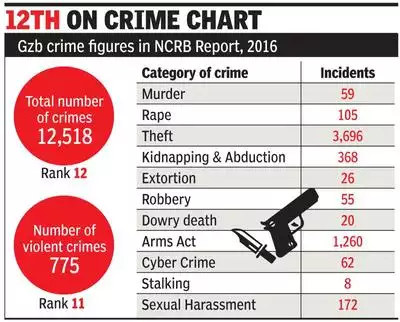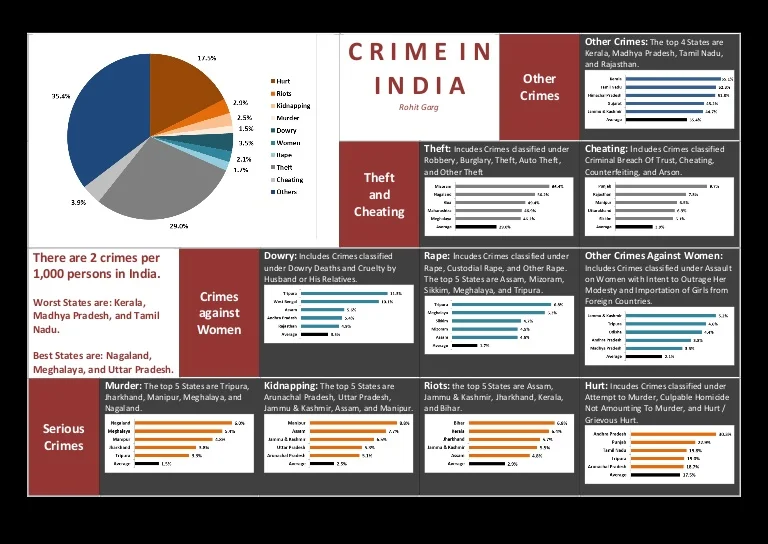
This article is written by Ananya Shri Singh of 3rd Year of BBALLB of Indore Institute of Law, an intern under Legal Vidhiya.
Abstract
Crime is considered as an unwanted activity that disrupts the social and moral fabric of the society. The term crime involves many activities and it is not confined to just one single activity, crime may include theft, robbery, extortion, dacoity, rape, criminal intimidation. For a crime to have the proper recognition, the criminal intention and criminal act.
The commission of criminal activities is depended on no single condition but depends on various cause which may include either sociological or psychological reasons. This article articulated the crime, elements, stages that are involved in the commission of the crime.
Man since long has always tried to make best use of the natural resources, he first started with food, then weapon in order to protect themselves. The aim was to use resource, further with the discovery of fire they started cooking their own food, in order to protect themselves from bad weather they even started wearing clothes.
Keywords: Crime, dacoity, robbery, extortion, intention, criminal activity.
INTRODUCTION
Man is believed to have evolved from a ham- such like ancestor. With the elaboration of man has evolved his mind. Man started using the raw leaves, insects and creatures as his food. latterly, on discovery of fire, he learnt that food was toothy when cooked. He used beast skin to cover his body. He stayed in grottoes to cover himself from the extremities of the climatic conditions. From raw leaves to pizzas and burgers, from fire to micro-wave ranges, from beast skins to pepe jeans, reebok shoes, etc and from grottoes to towers, we can see how mortal mind and thinking has evolved and led to the ultramodern day comfortable and luxurious living. The thinking has evolved in both the positive as well as negative perspectives. Though the mortal mind created luxuries, due to contemporaneous in- crinkle in population, numerous people were deprived of the basic musts which led to the development of the negative thinking. People wanted to fulfil their introductory musts at any cost and hence they started resorting to crime.
CRIME AND ITS MEANING
Crime is an offense which violates the law of state and is dis- approved by the society. In olden days, the crime rate wasn’t veritably high. But as time progressed, the crime rate has in- crinkled alarmingly. This increase in crime rate may be due to colourful causes and social problems. This composition focuses on conception of crime, rudiments of crime, criminology, colourful stages in commission of crime, causes of crime and types of crime.
WHAT’S CRIME?
Crime is a public wrong. It’s an act of offense which violates the law of the state and is explosively disapproved by the society. Crime is defined as acts or deletions interdicted by law that can be penalized by imprisonment or forfeiture. Murder, thievery, burglary, rape, crapulous driving, child neglect and failure to pay levies are exemplifications of crimes. The term crime is deduced from the Latin word “crimen” meaning offence and also a wrong- doer. Crime is considered as anti-social gesture
Each society may define crime in a different perspective. A crime may be legal or illegal. Illegal and punishable crime is the violation of any rule of administration or law of the state or practice of any wrongdoing and dangerous to tone or against third parties, handed in felonious law. Legal and not discipline- suitable crime is all acts of tone-Défense
ELEMENTS FOR CRIME
For an act of crime to be fulfilled, the following four rudiments are demanded · Individual The first and the most important element for commission of a crime is an existent who has an intention and is prepared to commit a crime. · Mens rea Mens rea in Latin means “shamefaced mind”. For a crime to be committed, a felonious intention is an essential element. · Actus rea Actus rea in Latin means “shamefaced act”. For a crime to be committed, along with a felonious intention there should also be an external act. · Injury hurt the felonious act should be accompanied by an injury or hurt which is physical, internal or financial which violates a law of state.
STAGES OF CRIME
Stages of committing a crime. The commission of crime involves four stages · Intention For the commission of crime, the first important stage is felonious intention. still, just having a felonious intention isn’t punishable until it’s conveyed to someone differently in words or by acts. illustration an intention to kill someone.
- Root To commit a crime, previous medication is necessary if the crime is purposeful. It’s difficult for the court to discipline an individual purely grounded on a medication plan until and unless it’s executed. For illustration, murder, dacoity, etc. ·
- primary crime an attempt to commit a crime is considered as primary crime. An attempt should include a felonious intention, an act towards committing a crime and an act of crime which isn’t fully accomplished. illustration Attempt to murder
- Completion of crime This is the last stage in commission of crime. The felonious completes the crime. A suspect is shamefaced of an offence only if he succeeds in his felonious exertion. illustration Successful accomplishment of murder Causes of crime. No existent is a born miscreant, it’s the situations and the conditions around the existent which make him act as a miscreant.
VARIOUS CRIME MENTIONED UNDER INDIAN PENAL CODE AND RELATED CASE LAWS
There are many crimes which are mentioned in Indian Penal Code, 1860 which is a substantive law and also prescribes punishment for disrupting the harmony of the society.
These are as follows:
- Rape
Rape has been defined under section 375, IPC, 1860, rape is establishing a physical relationship with women with force, and without her consent. The insertion of any object besides any part of the male body into the female body is said to be rape.
Punishment is described under section 376 which explicitly states that the any person who commits such offence shall be subject to rigorous imprisonment for not less than seven years and may also be extended for life time imprisonment.
In the instant case it was held by the honourable court that rape includes all kinds of forcible penetration[1]. Here in this particular matter the court finally came to the conclusion that the term “against her will” is an essential part to constitute the offence of rape, here it was stated by the court that despite women resistance to sexual intercourse the man does so.[2]
- Theft
Theft can be and has been defined under Indian Penal code as the taking away of the movable property of a person without that person consent, here it is important to note that absence of knowledge or consent that the thing has been taken away is important and forms and essential part of the offence.
Further the punishment for commission of theft has been defined under section 379 of Indian Penal Code, which states that a person who has been convicted of theft will be subjected to punishment which may be extended to three years either with fine or he may also be punished with both the fine and the imprisonment. To further add dishonest intention is sufficient to establish that a person has committed the offence of theft.[3]
- Murder
Murder has been defined under section 300 this may be defined as commission of an act that would cause the death of a person or such bodily injury that will lead to the death of a person.
Punishment for murder has been mentioned under section 302 of Indian Penal Code, 1860 which states that person who has committed murder would be subjected to punishment for the rest of his life.
In the case it was held that it is up to the discretion of the court to limit the awarding of capital punishment. The severity of the case has to be looked into with a lot of care to award such a punishment that would keep a person for the rest of his life in jail.
- Unlawful assembly with armed weapons.
According to section 144 of the Indian penal code, if five or more than five persons armed with deadly weapon appear or assembly then that is considered as an offence. The reason behind the same is that presence of person encourages a person to do an illegal act and thus disrupts the social fabric of the society.[4]
A person so accused would be punishment for a term of two years of imprisonment, with fine or with both. The punishment of the unlawful assembly has been mentioned in the section 145 of the Indian penal code, 1860
LEGISLATIONS THAT HAVE BEEN INSTRUMENTAL IN MINIMISING THE CRIME.
- Indian Penal Code[5] – As mentioned earlier the Indian penal code has defined many offences and along with it the punishment has been incorporated in the code so that the offence can be minimised to some extended, and to create a sense of fear that if they disrupt the harmony they would be punished
- POCSO Act – The prevention of child from sexual offences act punishes those who try to sexually harass or assault a child below the age of 14 years.
- Human trafficking and Prevention Act – this act basically makes it an offence to illegally traffic women as well as general people and prescribes punishment for the same.
These laws are further incorporated or supported with other piece of legislation the Sexual Harassment of Women at Workplace (Prevention, Prohibition and Redressal) act, 2013, The Protection of women from Domestic Violence Act, 2005, The Juvenile Justice (Care and Protection of Children) Act, 2015.

WAY FORWARD AND THE NATIONAL CRIME BUREAU RECORDS

The report contains statistical information on cognizable crimes as reported in police stations during the reference time. Information on police casualties and police firing, police & civilians’ casualties is given in separate chapters to insure acceptable focus to these issues. Information on complaints against police labor force and custodial crimes has also been given in separate chapters. It has been our constant bid to ameliorate the compass, content, content and donation of the publication. In this connection, the Bureau has started publication of devoted chapters on cybercrimes, mortal trafficking, crime against elderly citizens, crime against non-natives inter-alia foreign excursionists, offences against the State, terrain related offences and seizures of arms & medicines by police. either, data on profitable crimes, recidivism and crime in railroads has also been given in separate chapters. Information on hijacking and hijacking is presented in respect of total population, women & girls and children independently. The rearmost edition has aggregate of 25 chapters.[6]
[1] Sakshi v. Union of India, Writ petition of 1997
[2] State of Uttar Pradesh v. Chottey Lal 2011 (2) SCC 550
[3] Pyarelal Bhargava v. State AIR 1973
[4] Moti Das v. State of Bihar AIR 1954 SC 657.
[5] Indian Penal Code, 1860
[6] Crime In India | National Crime Records Bureau (ncrb.gov.in)




0 Comments